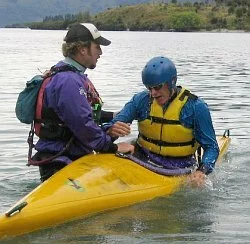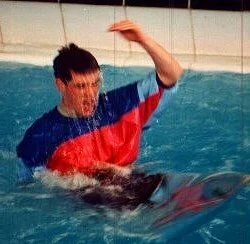|
Related Websites
Waterwear Guide
Clothes for Wild Watersports
waterwearguide.com
Sports Nutrition and Weight Control
vitaminbiz.com
Free Lifesaving Society
Get free lesson plans for survival swimming and lifesaving
freelifesavingsociety.com
Clothes for Swimming
Guide to a wide variety of swimwear
swimwearguide.com
|

Learn rolling with a friend.
Slap Stroke
Learning the sweep stroke.
|
Kayak Eskimo Roll
|
Two great skills to learn are the Eskimo Roll and Slap Stroke. Then you can roll your kayak over and get wet whenever you want. To roll your boat up again is an essential skill to save time or even your life. You can use your paddle to pull yourself up or you can learn the fine art of rolling up just using your hands.
Practice the Eskimo Roll often for Fun and Safety
The Eskimo roll allows you to turn the boat back into an upright position after capsizing. If you can master this technique, you should very rarely have to swim ashore and empty your boat of water.
The Pawlata Eskimo roll is the classic paddle roll, a slow motion sweep roll using an extended paddle. It is named after it's Austrian inventor Hans Pawlata, probably the first non-Eskimo paddler to roll a kayak. He taught himself to roll based on historical descriptions of artic explorers back in 1927.
Slap Stroke
The slap stoke is equally if not more important to learn and master. This particular paddling stroke allows you to slap the water as the boat starts to capsize; a slap of the paddle against the water stops the boat completely turning over, so no need to Eskimo roll. This technique becomes very important on moving/white water where hidden rocks are beneath the water.
Sit upright with your paddle in the high brace position. Begin to fall in to the left. As you fall rotate your body and begin to lean on the back deck of the boat. Start to sweep the water with the left hand paddle blade all the way round until you are upright.
PFD Roll
Best done using the sort of waist jacket PFD issued at water sports centres. Described for a capsize to the right.
- Attract attention from those you wish to impress.
- Capsize to the right.
- Remove PFD.
- For extra effect hold PFD just above right side of the boat and do up all zips and buckles.
- Allow PFD to float on surface.
- Hold PFD with both hands (or just one if really confident and flashy).
- Use the PFD for support for a strong hip-flick.
- Continue conversation as if nothing happened.
- Put PFD back on and lap up applause.
|

The hand roll is a great way to impress your pool buddies, even if you don't know the first thing about a forward stroke, they'll think you are a kayaking god.
"Oops, I fell out of the boat." If you mess up, just jump out.
|
Hand Roll
|
Impress your friends with this self rescue technique. The hand roll is a great move to master for a number of reasons. Most importantly, it's a confidence booster. Whitewater kayaking is as much about confidence as it is about skill.
Hand rolling is a method of righting a capsized kayak without using a paddle, but using the floatation of your upper body along with resistance from your hands and arms to allow a strong hip flick and delicate body positioning, returning your body weight to the kayak's centreline quickly by throwing an arm or sweeping your torso.
While there is an outside chance you might need to use this roll someday, the main benefit is to improve the technique and reliability of your paddle roll. It requires a solid rolling technique and an effective hip flick.
Once you learn the hand roll, you might even find that it becomes your preferred roll. It may be quicker to set-up underwater without the paddle if you know you can get up just as reliably using your hand roll. Of course this may leave you without paddle in the middle of a rapid, but for calmer water it might make sense.
The hand roll is a great skill to practice in an indoor pool during the winter months. Once you've mastered it then in the summer you can leave your paddle on shore at times and practice cool new things that will dramatically improve your overall paddling. Try some eddy turns and quick S-turns on a clean eddy line, or try surfing and spinning in small holes.
You'll become more aware of your body's position over your kayak and of how to let the river do more of the work for you, which will ultimately open the door to the moves you've only dreamed about.
|
Wear clothing that does not get in the way underwater when you capsize. |
Preparations
Make sure your clothing doesn't flap about, as it may get in your way in the water. A short sleeve top may be better for initial training, because a long sleeve anorak or hoodie can hold a lot of water in the sleeves.
If you wear a hooded top, tie the hood around your neck or put it up so it fits well. Make sure you can see even when you turn your head.
To prevent water from getting up your nose, you may prefer to wear a nose clip. Without a nose clip you will soon discover that breathing out slowly through your nose will prevent the water from going in.
It helps to gradually reduce the size of the paddle while practising, ending up with a ping-pong paddle or webbed glove, until finally you are able to roll back upright holding nothing but water and a giant sized grin.
|
You can push yourself off the shallow pool floor when you practice the hip-flick.
Pactice the hip flick holding on to another boat. Remember to use a spray deck or you sink the boat.
Put your arms to the side to which you plan to capsize.
Settle into an upside-down position.
|
Practice
First, the hand roll is misnamed. It should be called the leg roll, because, as in any well-executed roll, it is the legs that accomplish most of the work. In most hand rolls, the upper body, including the hand or hands, substitutes for the paddle that serves as a support.
You press the thigh of your lower leg upward against the thigh brace and push with your upper foot on the foot peg, an action which twists the boat virtually upright. This leg pressure is generally termed the "hip-flick", another misnomer, because it does not need to be applied quickly all at once, although it may be.
The Hip Flick
A good drill to learn the hip flick is to lean over and put your hands on the edge of a swimming pool. Lean over until your head touches the water.
Practice flexing (flicking) your hips from one side to the other, so that your boat flips from an upright position to an upside down position. It's all in the hips, but this is not a natural body movement, so you have to practice it.
Now lean back or forward onto the deck of the boat and do it again. This should be easier as you're closer to the axis of rotation, and thus need less leverage.
The Capsize
The capsize is the same no matter which way you choose to come back up. It a real capsize you may not have time to set up your roll. So get with it and train for any eventuality.
Roll towards the side of your choice. Wait until you are upside down. Get your bearings.
The Recovery
- Lean back onto the deck of your boat, look up towards the water surface. Reach with your hands towards the surface, palms down, away from your boat. Use like a paddle to get up.
- Push hard downwards or in a sweping move until your upper shoulder comes out of the water.
- Keep your head in the water, leaning right back on the deck. Pull your lower knee up and use your hip to flick the boat upright. Throw the upper arm out over the top of the boat. It acts as a counter weight and helps you turn upright.
- Stretch your lower arm and use it in a downward slapping motion to finish the roll.
Common Mistakes
- Don't lift your head too early out. That adds to the weight you want to shift. Keep your head in the water, it should come out last.
- Too much heavy clothing when you begin. Start with just jeans and a t-shirt or short sleeve canoeing cag to avoid chafing of the boat or spray deck. When you get better, try more kit.
|
|